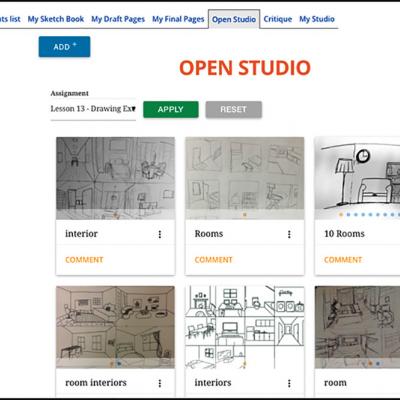
Doctoral candidates Help Create Online Studio for Graphic Design Course
When transferring a resident course to an online format, course designers face many challenges. Those challenges become even more complex for arts classes that require constant student interaction and feedback.
Jessica Briskin and Gary Chinn, doctoral candidates in the College of Education’s Learning, Design and Technology Program whose research focuses on the Learning Sciences, experienced those challenges firsthand while designing an online course that follows a studio-based instructional approach.
“We had the opportunity to collaborate with a graphic design professor to create an online course around graphic novels as a narrative device,” said Chinn, who works full time as the assistant dean for digital learning for the Office of Digital Learning in the College of Arts and Architecture.
“The challenge was to try and figure out how to work with this graphic design professor who had only done in-person, studio-based instruction and figure out what that could look like with technology,” he said.
“We were trying to look at how arts instruction happens and how it is different from a typical instructional approach,” added Briskin, who serves as a graduate assistant for the Office of Digital Learning.
In arts-based courses it is common for classrooms to follow a studio set-up where characteristics such as consistent feedback, peer assessment and openness are key elements. Classes also focus on the creation of artifacts (writings, drawings, sculptures, etc.), and peer evaluations and critique are required in order for students to make refinements and improve their work.
“An arts-based approach usually looks a little bit different than traditional classes. The conversations are different and the artifacts or products of the work are different as well,” Briskin said, adding that during the development process, she and Chinn tried to identify certain hallmarks of arts-based pedagogy and focus on them.
“A lot of what we tried to do with the platform was get at what a critique process could look like if students weren’t all together in the same room,” she said.
In fall 2016, Chinn and Briskin worked with Joel Priddy, associate professor of graphic design, to pilot a new hybrid approach to his Introduction to Graphic Novels course. The trio decided on this approach to learn what works best in both a face-to-face and online environment before launching the courses solely online. Piloting the course in this format was beneficial, Chinn said, because they were able to make immediate changes and updates.
“There are many developers across campus who have worked on our studio and so based on feedback from the students and the professor, we were able to make changes on demand,” he said.
“The students all gave really positive feedback to their online experience and that was a little bit surprising because we expected one or two students to have a negative experience,” Briskin added. “We did interviews and had survey feedback and they all reported having a very good experience. So that leads us to believe that we did something right.”
“This feedback is very reassuring because the studio design is kind of the catalyst to start research for other projects in the Office of Digital Learning,” she said. “A lot of what we did is helping to inform how other arts classes or arts-based instruction could use this virtual, online studio as well.”
Studying the Learning Sciences and focusing on the design of education in online spaces is important not only to the field of education but also to current and future students, Chinn said.
“There are populations of learners who for various reasons cannot attend in-person educational experiences,” he said. “Look at [Penn State] World Campus, for example. Most of the students enrolled are adult learners who have children. The average age at the undergraduate level is 33. So, it is a much different population than you see on campus.
“Designing online educational experiences like the online studio unlocks the ability for these learners to pursue certain disciplines that otherwise would not be possible for them to do because the only other options are resident experiences,” Chinn said, explaining that arts-based disciplines are rarely an option for online learners because of the unique studio-based instructional model most classes follow.
Although Chinn’s and Briskin’s research and work developing an online studio classroom specifically benefits the College of Arts and Architecture, they believe it is applicable to other disciplines and already have seen interest from faculty at other universities.
“We recently presented at AERA,” Briskin said. “It was a roundtable discussion and a lot of people, many from the Learning Sciences, were interested in ways they could use our virtual studio. They found the collaborative, critiquing process extremely interesting and saw ways that they could use our technology to meet their needs.
“Our research is applied,” she said. “The way in which we structure the studio and the methods we use, especially for collaboration and critiquing, can inform other disciplines and how they design their online classes.”
Briskin and Chinn’s creation also is the driving force behind a new interdisciplinary online program among the College of Arts and Architecture, Donald P. Bellisario College of Communications and College of Information Sciences and Technology. The program — Digital Multimedia Design — launched this past summer.
“A lot of the work that went on last fall led to direct improvements that are being rolled out on the program level,” Chinn said, adding that he and Briskin will do additional data collection this fall to draw comparisons and evaluate areas of improvement.
“With the Learning Sciences and online innovations, there are a lot of possibilities for the future,” Briskin said. “And those of things we will look into as this process continues.”
Briskin and Chinn detailed their process of creating the online studio in a case study published in the UAL Creative Teaching and Learning Journal in March 2017. Their adviser, Susan Land, associate professor of learning, design and technology, and Joel Priddy served as co-authors for the article.
– Jessica Buterbaugh
